Brush
InkFlow
InkFlow Tool
InkFlow Panel
Opacity Brush
Opacity Brush Tool
Texture Brush
Texture Brush Tool
Width Brush Tool
Illustrator Location:
Advanced Toolbar > Shaper Stack > InkFlow Tool
Tool Location and Cursor Appearance
The InkFlow tool appears in Illustrator’s main toolbar (which must be in Advanced mode: View > Toolbars > Advanced), stacked under the native Shaper and Pencil tools. As with other stacked tools, click and hold on the top tool icon to display the tools stacked under it.
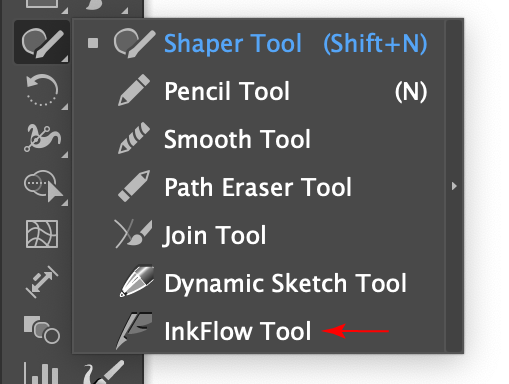
InkFlow Tool Location
The InkFlow tool’s cursor is a quill. When the mouse button is up, the shape of the pen tip is annotated underneath it with an ellipse. When closing a path, or continuing/editing an existing selected path, a “link” badge is added.

InkFlow Cursors
Illustrator Location:
Advanced Toolbar > Shaper Stack > InkFlow Tool
The InkFlow tool works largely in conjunction with the associated InkFlow panel, which should generally be open and accessible. If you are using the free Astute Graphics plugin DirectPrefs, you can have the InkFlow panel automatically be shown when the InkFlow tool is selected.
After selecting the InkFlow tool from the toolbox (or by clicking on the blue panel banner in the InkFlow panel), simply drag it to create a calligraphic stroke, in which the ellipse representing the tip is extruded along the tool’s path. The tool’s size, roundness, and angle will reflect what is specified on the panel.
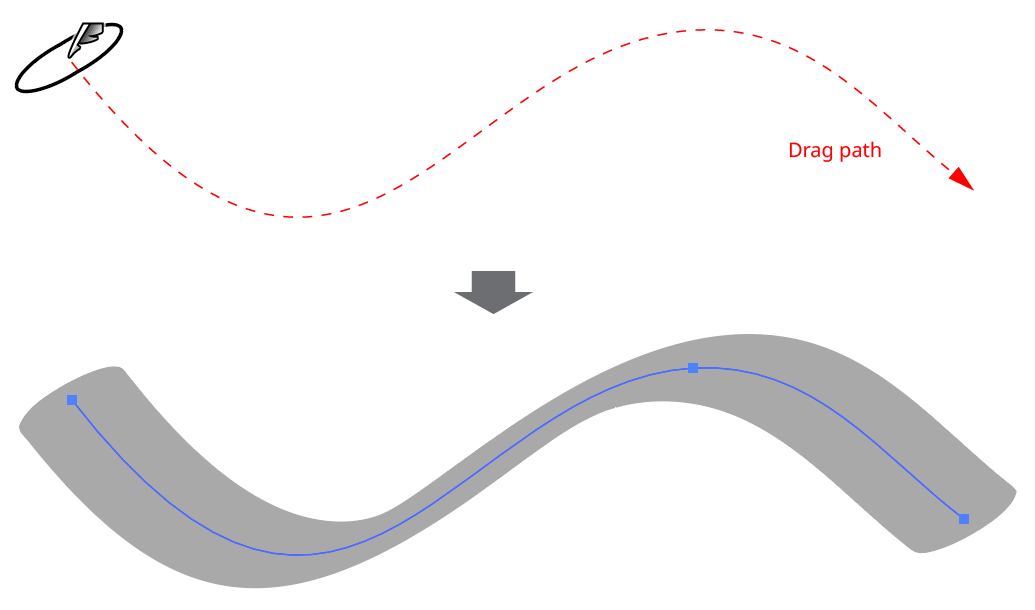
InkFlow Basic Example
The pen’s size can be adjusted (before, but not while dragging) by using the keys assigned to Decrease Diameter and Increase Diameter in the native Keyboard Shortcuts dialog (the left and right square bracket keys respectively, by default, for English language keyboards). If one or more InkFlow paths are selected, the first use of either keypress will deselect the path(s) rather than change the size. The pen size may also be changed via the InkFlow panel. When using a stylus input device, and pressure-control is enabled for the pen size, the cursor’s preview ellipse shows its maximum size.
While dragging, a preview of the stroke will be shown (in black, by default). Just as with the native Brush, this preview is only approximate and is not as smooth or refined as the final stroke.
An existing InkFlow path can be continued or reshaped by the InkFlow tool as long as the path is selected and the Edit Continue Selected Paths preference is enabled (which is the default). Additionally, the cursor must start within a certain distance (specified in the preferences dialog) of the existing path. When this is the case, the cursor will display a “link” badge, indicating that Edit/Continue mode is active. Dragging will then edit or continue the existing path, much like the native Pencil tool. Two InkFlow paths can also be joined together; the joined path will receive the appearance of the path which is lower in the stacking order.
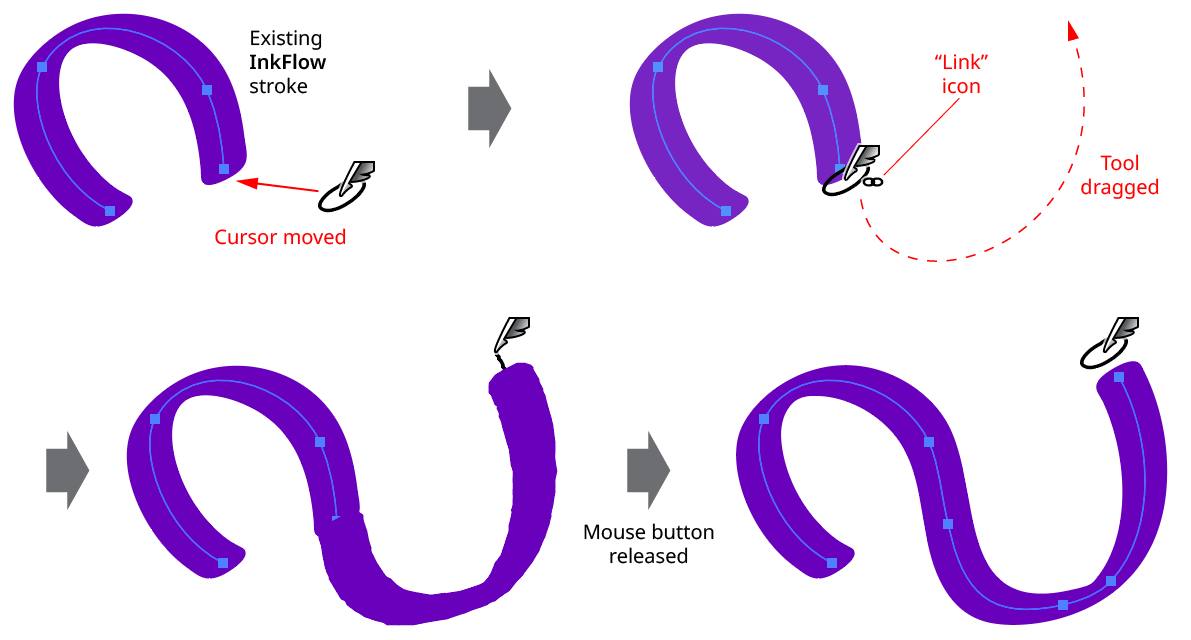
InkFlow Continue Path
Unless the InkFlow preference Expand Strokes is enabled, paths drawn with the InkFlow tool will be assigned the InkFlow live effect, which can be seen in the Appearance panel. As with all live effects, it can be hidden or shown, moved to a different path, or have its parameters changed any time after the path was drawn (using the InkFlow panel), which allows you to try different looks without having to repeatedly redraw the path from scratch.

InkFlow Changing Parameters
Like the Astute Graphics Dynamic Sketch tool, the InkFlow tool cursor is pulled by a virtual “string,” which can be set from 1 to 100 pixels in length. A pulled cursor has the effect of smoothing out small jitters in its motion, resulting in a smoother path. With higher string lengths, sharp corners can be easier to create, because moving backwards slightly with the cursor simply creates slack on the string without creating new path points; the cursor can then be pulled in a new direction to create the sharp corner.

InkFlow Pulled Cursor
When an InkFlow path is drawn, it is given a stroke (unless the new art style already has one) and any fill is removed. The InkFlow live effect is added and positioned below the stroke and fill, and replaces the basic stroke. Adding a fill color generally only makes sense if the drawn path is closed.
However, if the InkFlow live effect is moved to the top of Appearance stack, then the stroke and fill are applied to the outline of the calligraphic stroke, allowing additional creative possibilities:
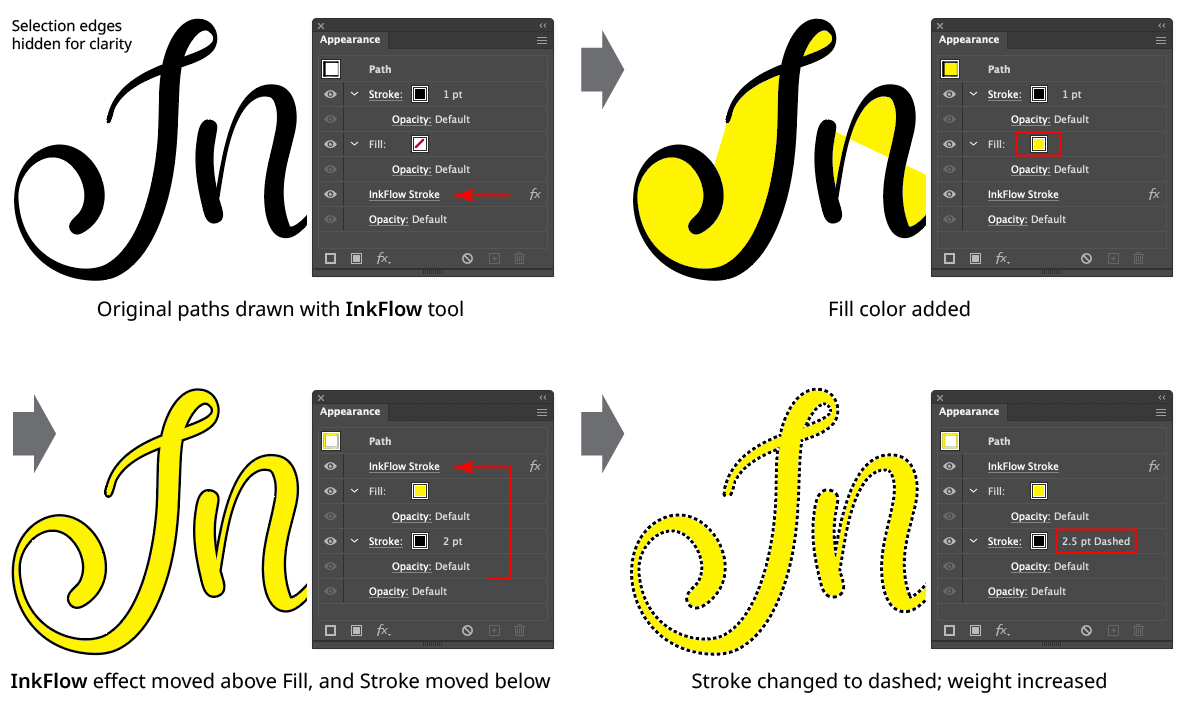
InkFlow Live Effect Positioning
Although InkFlow is a live effect, it is not possible to add it directly from the live effects menu like most live effects. Instead, at least the first instance must be generated by the InkFlow tool.
Other features and operations of the InkFlow tool are discussed in conjunction with the InkFlow panel, below.
Illustrator Location:
Illustrator Main Menu > Window > Astute Graphics > InkFlow
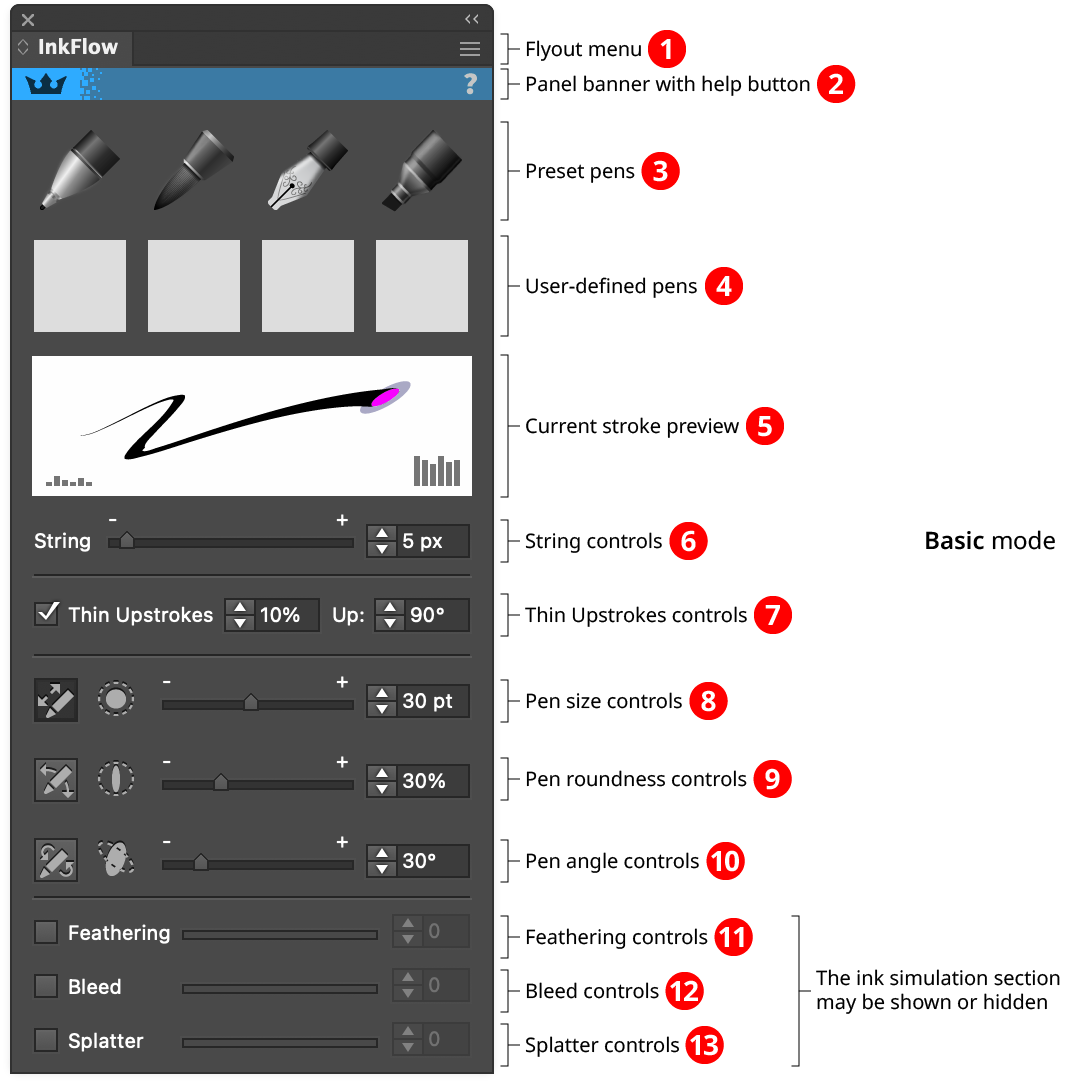
InkFlow Panel (Basic Mode)
1. Flyout menu
See InkFlow Panel: Flyout Menu.
2. Panel banner
The InkFlow panel banner has a help button on the right which opens the help documentation in the Astute Manager. If this does not automatically appear, please ensure your Astute Manager is running first. Also, the panel banner can be clicked to activate the InkFlow tool. This is a quick method of locating the tool within the default Advanced toolbar or a custom toolbar.
3. Preset Pens
InkFlow offers four preset pens with different characteristics. Each may be selected by clicking on the corresponding icon in the top row, which will highlight in blue. Each pen may be customized by selecting it, changing its parameters using the panel controls underneath, and then Option/Alt-clicking on the icon. To reset a preset pen back to its default values, Shift-click on it (or all of the preset pens may be reset by using the panel flyout menu item Reset Standard Pens). If one or more InkFlow strokes are selected when a pen is selected, their strokes will be changed to match the selected pen’s.
a. Ballpoint Pen Preset: The Ballpoint Pen preset is designed to imitate a typical ballpoint pen, with a small round tip, and slight upstroke thinning.
b. Brush Pen Preset: The Brush Pen preset is designed to imitate a fiber-tipped brush, with a larger round tip and high upstroke thinning.
c. Calligraphic Pen Preset: The Calligraphic Pen preset is designed to imitate a shaped pen used for calligraphy. It has a highly-elliptical tip and very high upstroke thinning.
d. Marker Pen Preset: The Brush Pen preset is designed to imitate a wide, chisel-tipped marker. It has a larger, highly-elliptical tip and no upstroke thinning.
4. User-Defined Pens
You can define up to four pens of your own, which can be recalled by simply clicking on one of the boxes. To define a pen, adjust the panel parameters to their desired values and then Option/Alt-click on one of the boxes to store it. While a user-defined pen cannot be named, an image of its stroke will appear.
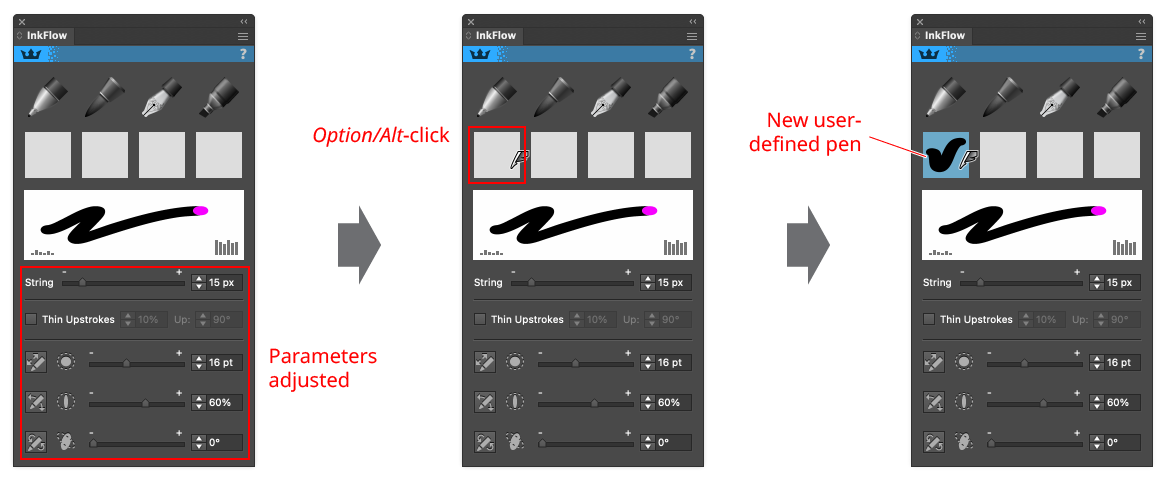
InkFlow Panel User Defined Brush
To remove a user-defined pen, Shift-click on its box.
5. Current Stroke Preview
Shows a preview of the stroke that would be produced by the current pen, if it were moved from left to right with increasing pressure. When the pen size is too large to be drawn correctly (more than about 30 pt), it will be shown in a dimmer color around its scaled-down version (drawn in magenta). The preview reflects the Thin Upstrokes parameter, and if enabled, the effective pen size may be smaller than the nominal size.
6. String Controls
The InkFlow cursor is pulled by a virtual “string,” the length of which is specified here, from 1 to 100 pixels. Changing the string length will not change existing selected InkFlow strokes; however, the parameter is saved and recalled with each pen preset. The virtual string acts very similarly to a real string. When it is taut, pulling the string has the effect of dragging the pen in the same direction. However, pushing on the string, or dragging when it is not taut, has no effect on the pen position. A very short string has the effect of stabilizing the pen and filtering out small tremors. This is particularly useful with stylus input devices, which are more susceptible to hand tremor than mice. A longer string changes the characteristics of the pen: it becomes smoother and draws either very shallow curves, or makes tight corners when the string is relaxed and pulled in a different direction.
7. Thin Upstrokes Controls
When Thin Upstrokes is enabled, drawing with the pen in the direction specified as “Up” will cause its size to decrease, reflecting the way some physical pens behave, and useful for calligraphy. The amount of thinning can be specified from 1% to 100%, where 20% means a stroke exactly in the “Up” direction would be only 20% of the width of a stroke in the opposite direction (a stroke only partly in the “Up” direction would get partial thinning). By default, the “Up” direction is actually upwards (90°, as specified in Illustrator), but can be changed to any value.
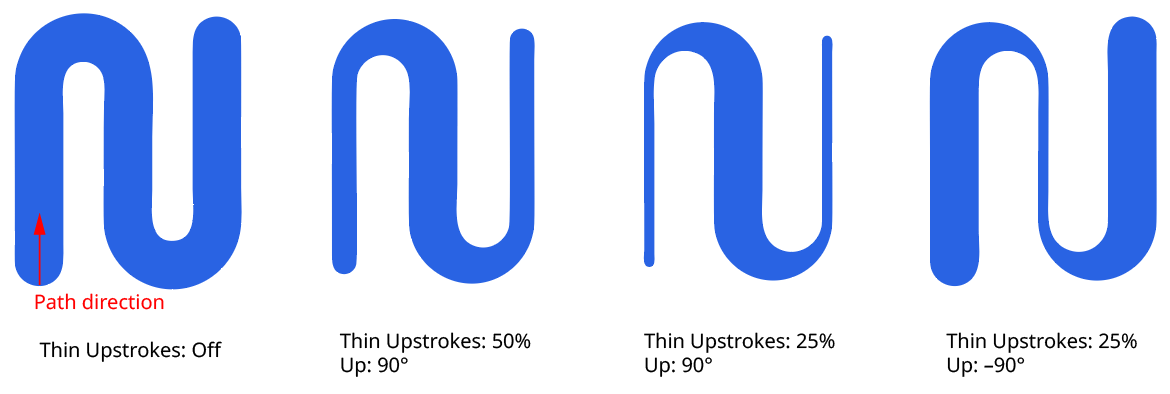
InkFlow Thin Upstroke Examples
8. Pen Size Controls
These controls specify the size of the pen. The slider and value input allow the size to be directly specified, from 1 pt to 1296 pt. The button at left allows pressure control for tablet input devices; when using a mouse it should be kept off. When it is enabled, the specified size value represents the maximum size; the minimum size may be specified by using the control on the Expanded mode panel (see InkFlow Panel Expanded Mode).
9. Pen Roundness Controls
These controls specify the roundness of the pen. The slider and value input allow the roundness to be directly specified, from 1% (an extremely narrow ellipse; nearly a straight line) to 100% (circular). The button at left allows tilt control for tablet input devices; when using a mouse it should be kept off. When it is enabled, the specified roundness value represents the maximum value; the minimum value may be specified by using the control on the Expanded mode panel (see InkFlow Panel Expanded Mode).
10. Pen Angle Controls
These controls specify the angle of the pen tip (which is only relevant if the roundness is set to a value other than 100%). The slider and value input allow the angle to be directly specified. The button at left allows bearing control for tablet input devices; when using a mouse it should be kept off. When it is enabled, the specified angle value represents the default value at neutral bearing; the variance may be specified by using the control on the Expanded mode panel (see InkFlow Panel Expanded Mode).
11. Feathering Controls
These controls may be hidden using the panel flyout menu Hide Ink Simulation Controls. Feathering occurs when capillary action causes ink from the pen to be drawn along the fibers of the paper. It creates very fine, thin lines perpendicular or near-perpendicular to the stroke. The InkFlow simulation is designed to be viewed at up to about twice screen resolution, where it creates a fuzziness to the edge and softens it. It doesn’t look realistic at higher zoom levels, due to point count considerations. The feathering value may be set from 0 to 100, with values below about 60 producing fairly subtle results, and values above 85 making the stroke look very spiky.

InkFlow Feathering Examples
12. Bleed Controls
These controls may be hidden using the panel flyout menu Hide Ink Simulation Controls. Bleeding occurs when the pen is brought into contact with and taken off the paper. When a pen is brought into contact with the paper, there is usually a pause, during which time the ink seeps into a circle around the contact point. When it is removed from the paper, it is generally not removed cleanly, and there is an uneven trail during the short period when pen is only partially in contact with the paper. Enabling Bleed in InkFlow simulates both of these effects. For the end of the stroke, the brush trails are randomly generated, and toggling the effect will generate a different look each time.
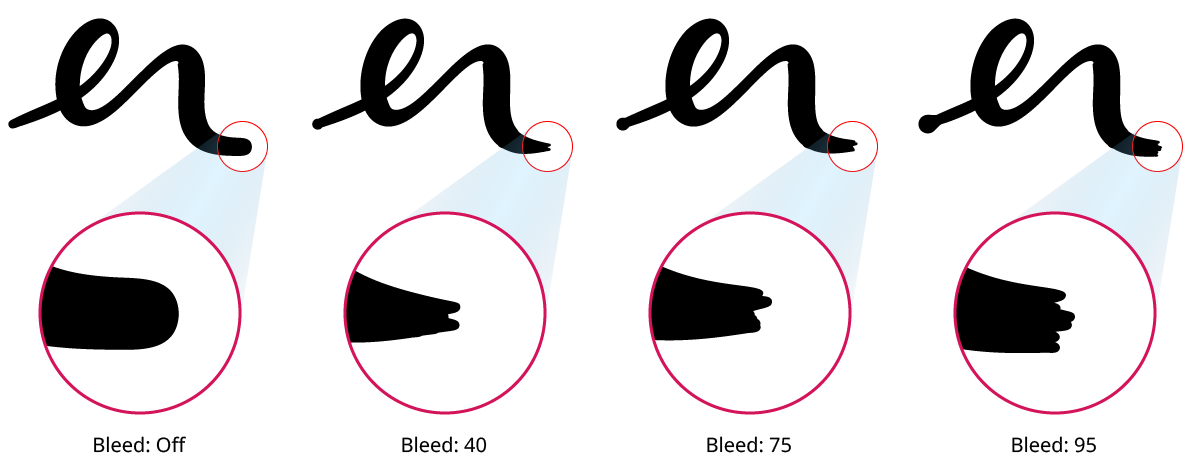
InkFlow Bleed Examples
13. Splatter Controls
These controls may be hidden using the panel flyout menu Hide Ink Simulation Controls. Although splatter generally isn’t seen with modern pens, it does occur in some historical manuscripts. It’s also an artistic way of suggesting real ink. When Splatter is enabled, tiny paths representing droplets surround the stroke, some of them forming teardrop-shaped splashes. The splatter dots are randomly generated, and toggling the effect will generate a different look each time.
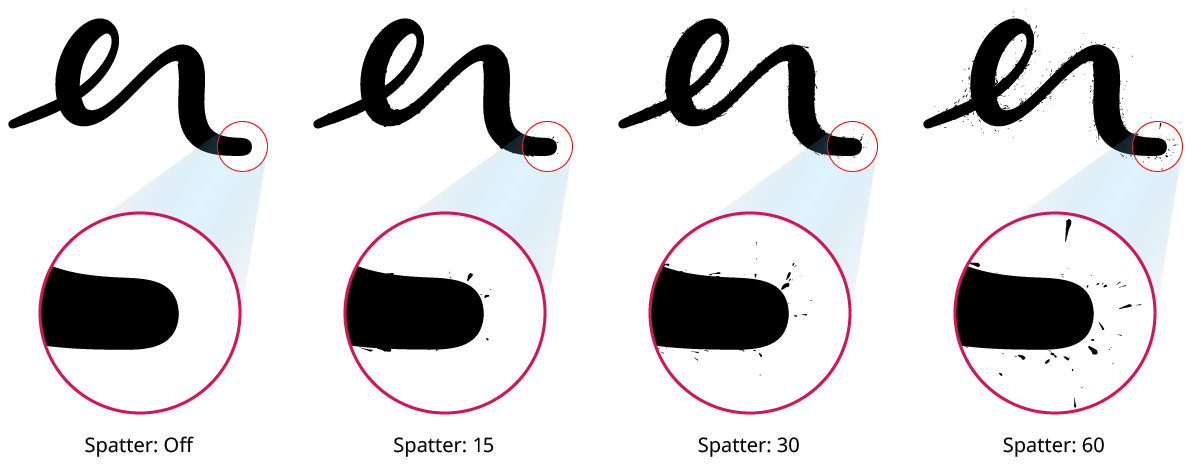
InkFlow Splatter Examples
Illustrator Location:
Illustrator Main Menu > Window > Astute Graphics > InkFlow
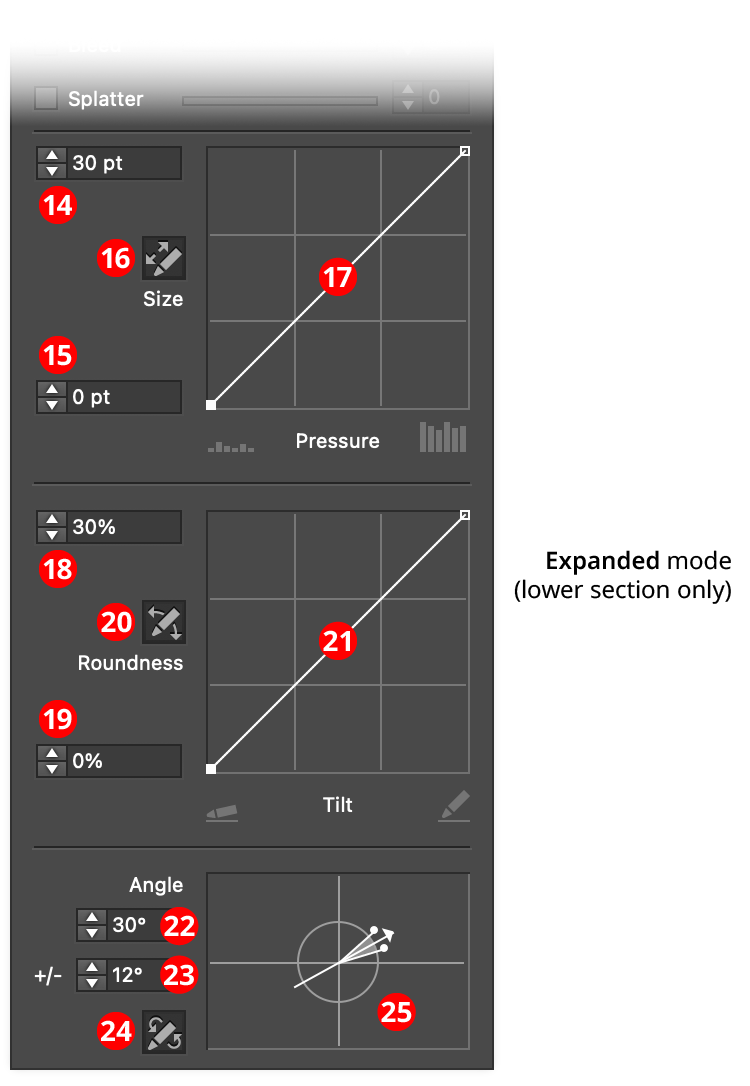
InkFlow Panel (Expanded Mode)
14. Size/Maximum Size
If pressure control is off, this value specifies the size of the pen. Otherwise, it specifies the maximum size that the pen can reach, at a pressure which is dependent on the size-pressure curve.
15. Minimum Size
The minimum size that the pen can reach, at a pressure which is dependent on the size control graph.
16. Size-Pressure Button
When toggled into the enabled state (the button will be dark), the pen size is variable, and based on the amount of pressure created by a stylus or similar input device.
17. Size Control Graph
Specifies the relationship between the maximum and minimum size values and the input pressure. The horizontal axis represents the pressure, from 0% to 100%, while the vertical axis represents the brush size, specified by the maximum and minimum value inputs. With the default diagonal line, the relationship is a linear one, with minimum pressure yielding minimum size and maximum pressure yielding maximum size. Nodes on the curve may be moved simply by clicking and dragging them. A new node may be added by clicking at a spot along the curve which does not already have a node. Nodes (except the ones at the beginning and the end of the curve) may be deleted by dragging them off the graph area.
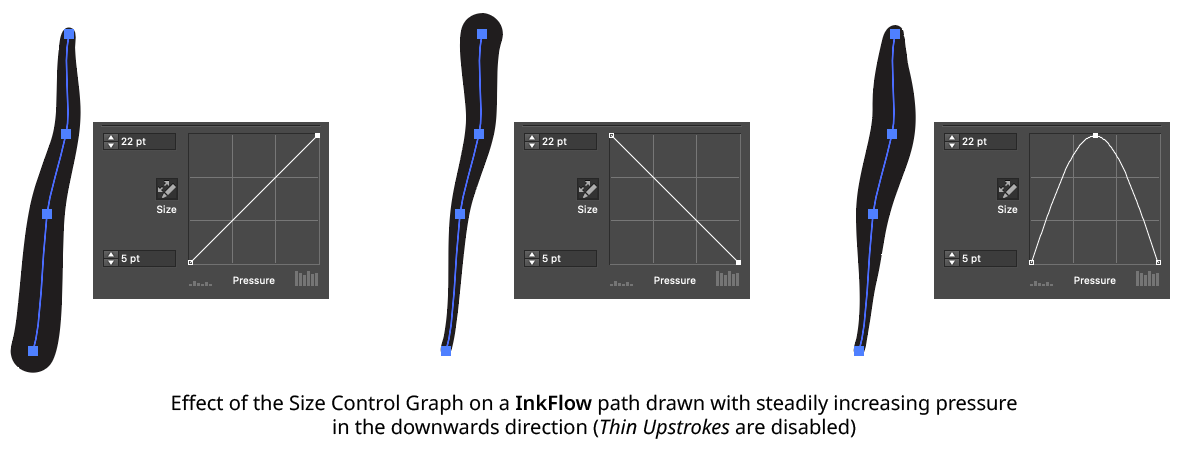
InkFlow Size Control Graph Examples
18. Roundness/Maximum Roundness
If tilt control is off, this value specifies the roundness of the pen. Otherwise, it specifies the maximum roundness that the pen can reach, at a tilt which is dependent on the roundness-tilt curve.
19. Minimum Roundness
The minimum roundness that the pen can reach, at a tilt which is dependent on the roundness-tilt curve.
20. Roundness-Tilt Button
When toggled into the enabled state (the button will be dark), the pen roundness is variable, and based on the amount of tilt reported by a stylus or similar input device.
21. Roundness Control Graph
Specifies the relationship between the maximum and minimum roundness values and the input tilt. The horizontal axis represents the tilt, from almost flat to completely upright, while the vertical axis represents the brush roundness, specified by the maximum and minimum value inputs. With the default diagonal line, the relationship is a linear one. Nodes on the curve may be moved simply by clicking and dragging them. A new node may be added by clicking at a spot along the curve which does not already have a node. Nodes (except the ones at the beginning and the end of the curve) may be deleted by dragging them off the graph area.
22. Angle/Base Angle
If bearing control is off, this value specifies the angle of the pen tip. Otherwise, it specifies the base angle to which an additional amount is added or subtracted, depending on the bearing and the angle-bearing curve.
23. Angle Variability
The maximum variability in angle (from 0° to 90°) that can be created by different bearing values.
24. Angle-Bearing Button
When toggled into the enabled state (the button will be dark), the pen angle is variable, and based on the bearing value reported by a stylus or similar input device.
25. Angle Widget
Visualizes the angle and angle variability settings, and allows them to be edited graphically by dragging the angle arrowhead or the variability dots. An overly-wide spread will tend to create undesirable results because of the speed at which stylus bearing can change, and interpolation issues.
Illustrator Location:
Advanced Toolbar > Opacity Brush Tool
Tool Location and Cursor Appearance
The Opacity Brush tool appears in Illustrator’s main toolbar (which must be in Advanced mode: View > Toolbars > Advanced).

Opacity Brush Tool Location
The Opacity Brush tool’s cursor is a crosshair. When the tool is not actively brushing, or when brush previews are disabled, it also displays a dark gray, dashed circle (or ellipse) indicating the size and shape of the brush:

Opacity Brush Tool Cursors
A minus sign symbol indicates that the brush is in “erasing” mode.
Illustrator Location:
Advanced Toolbar > Opacity Brush Tool
As the Opacity Brush tool has several keypresses which can add or change its functionality, we suggest installing the free Astute Graphics plugin Astute Buddy, which creates a panel that dynamically updates to inform you of the various keys which can be pressed in the tool’s current context.
While the Opacity Brush tool can be used without its panel, some functionality, such as adjusting the amount of noise, requires the panel to access.
To use the tool, simply brush over selected artwork to make it “fade out” in those areas. Opacity Brush automatically creates a raster opacity mask for each selected art object that is not part of the same group. The raster has a default resolution of 72ppi, but the value can be changed in the tool Preferences dialog (see Opacity Brush: Preferences).
If the artwork already has an opacity mask, the raster object will be added to it, at the bottom of the stacking order. If the existing mask was set to invert, this setting will be retained and the brush will appear work in an inverted manner.
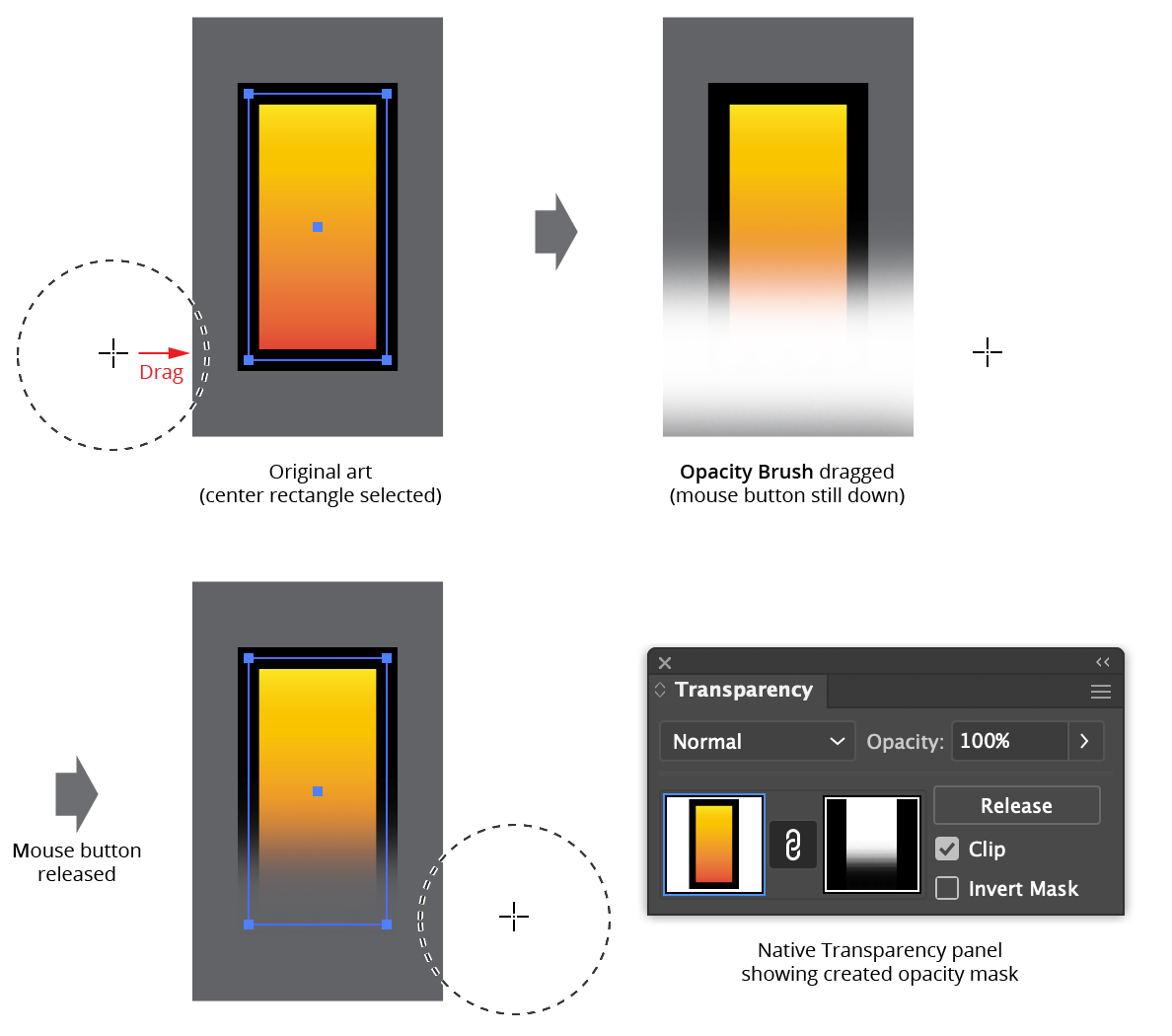
Opacity Brush Example
The Opacity Brush tool’s preview can be changed in its preferences; by default, it is white and shows its size, hardness, and opacity faithfully, similar to how a Photoshop brush would draw. Due to technical limitations of Illustrator, this requires CPU preview to be enabled in order to display properly when brushing long distances.
If the Option/Alt key is held down before brushing, the tool will be set to “erasing” mode, whereby each brush stroke adds opacity to the artwork (up to a maximum of 100%), instead of removing it. Like other brush tools, the diameter of the brush can be changed at any time it is active by pressing the keys assigned in the native Keyboard Shortcuts dialog to “Decrease Diameter” and “Increase Diameter.” For English language installations, these default to the open square bracket and close square bracket keys ([ and ]).
Another way to change the brush diameter (and hardness) is to hold down Shift-Option/Alt and click-drag the mouse; this adjusts the diameter. After releasing Shift-Option/Alt (and with the mouse button still down), a second drag will adjust the hardness.
While brushing (i.e., with the mouse button down), several keypresses can be used:
Shift: Constrains the brush motion to the nearest increment of 45° around the general constrain angle.
Left/Right Arrow: Decreases or increases the brush diameter.
0–9: Sets the brush opacity. 1 sets the opacity to 10%, 2 to 20%, etc.
D: Changes the drawing annotation color, cycling through red, blue, magenta, green, black, and white.
E: Changes the erasing annotation color, cycling through red, blue, magenta, green, black, and white.
To reset, invert, or remove the opacity mask created by the Opacity Brush tool, use the Opacity Brush panel.
Illustrator Location:
Illustrator Main Menu > Window > Astute Graphics > Opacity Brush
The menu item to show and hide the Opacity Brush panel can be found in the main menu under Window > Astute Graphics > Opacity Brush.
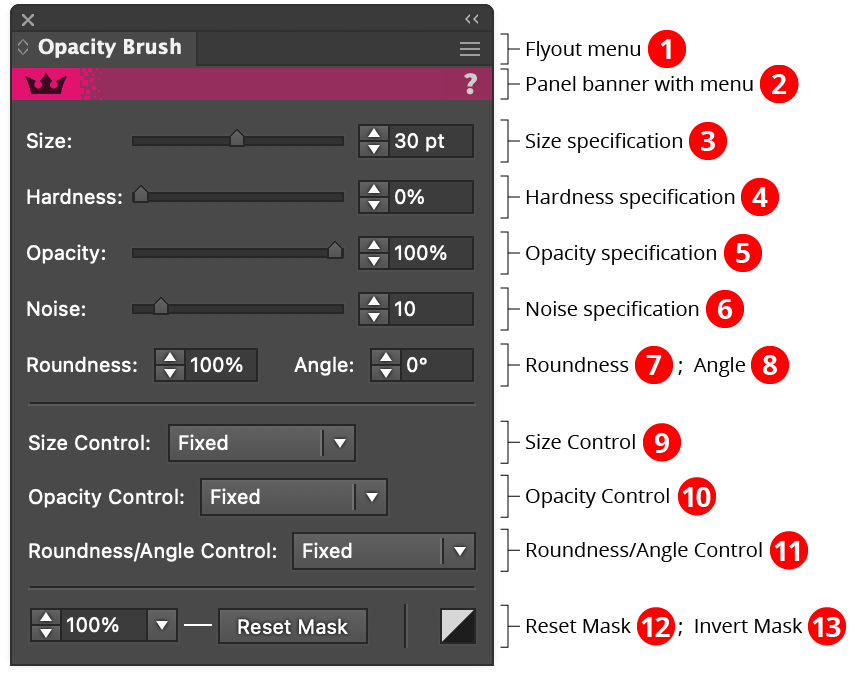
Opacity Brush Panel
1. Flyout menu
See Opacity Brush Panel: Flyout Menu.
2. Panel banner
The help button on the right opens the help documentation in the Astute Manager. If this does not automatically appear, please ensure your Astute Manager is running first.
Click on the other area of the color bar to activate the Opacity Brush tool. This is a quick method of locating the tool within the default Advanced toolbar or a custom toolbar.
3. Size Specification
The size (diameter) of the brush, from 1pt to 1000pt.
4. Hardness Specification
The hardness of the brush, from 0% to 100%.
5. Opacity Specification
The opacity of the brush, from 0% to 100%.
6. Noise Specification
The amount of noise in the brush, from 0 (no noise) to 100 (maximum noise).
7. Roundness
The roundness of the brush, from 10% (highly elliptical) to 100% (circular).
8. Angle
When the brush is not at 100% roundness, the angle of the major axis of its elliptical shape.
9. Size Control
Visible when the panel is expanded. When using a mouse as the input device, it should be set to Fixed; otherwise, enables the brush size to be controlled by either the pressure or wheel setting of a stylus-like device.
10. Opacity Control
Visible when the panel is expanded. When using a mouse as the input device, it should be set to Fixed; otherwise, enables the brush opacity to be controlled by either the pressure or wheel setting of a stylus-like device.
11. Roundness/Angle Control
Visible when the panel is expanded. When using a mouse as the input device, it should be set to Fixed; otherwise, enables the brush opacity to be controlled by either the tilt/bearing or tilt/rotation setting of a stylus-like device.
12. Reset Mask
Visible when the panel is expanded. The value input specifies the base opacity of the entire mask when it is reset (or first created, if the tool preference Base Opacity Applies to New Masks is enabled), with a default of 100%. The Reset Mask button resets the mask, removing all existing brush strokes that may have been made to it and filling it with the base opacity specified in the value input box.
13. Invert Mask
Visible when the panel is expanded; inverts the raster portion of the opacity mask.

Opacity Brush Panel Invert Mask
Illustrator Location:
Advanced Toolbar > Texture Stack > Texture Brush Tool
Tool Location and Cursor Appearance
The Texture Brush tool appears in Illustrator’s main toolbar (which must be in Advanced mode: View > Toolbars > Advanced), stacked the associated Texture tool. As with other stacked tools, click and hold on the top tool icon to display the tools stacked under it.

Texture Brush Tool Location
The Texture Brush tool’s cursor is a crosshair. When the tool is not actively brushing, or when brush previews are disabled, it also displays a dark gray circle (or ellipse) indicating the size and shape of the brush:

Texture Brush Tool Cursors
A minus sign symbol indicates that the brush is in “erasing” mode.
Illustrator Location:
Advanced Toolbar > Texture Stack > Texture Brush Tool
As the Texture Brush tool has several keypresses which can add or change its functionality, we suggest installing the free Astute Graphics plugin Astute Buddy, which creates a panel that dynamically updates to inform you of the various keys which can be pressed in the tool’s current context.
While the Texture Brush tool can be used without its panel, some functionality, such as adjusting the amount of noise, requires the panel to access.
As initially applied, a Texture live effect only has an overall opacity. However, you may want the texture to fade out in certain areas, perhaps to achieve a more three-dimensional look, or to make overlaid text more legible. While the Texture effect could be expanded and an opacity mask created manually, it is much easier to simply use the Texture Brush and “brush” the opacity changes directly onto the texture. Within the live effect, this adds an opacity mask, with a default resolution of 72ppi, but the value can be changed in the tool Preferences dialog (see Texture Brush: Preferences).
With at least one object with a Texture live effect selected, dragging the Texture Brush tool over visible parts of the texture reduces its opacity (if the Texture Brush opacity is set to 100%, the texture’s opacity will be reduced by 100%, i.e., completely removing it).
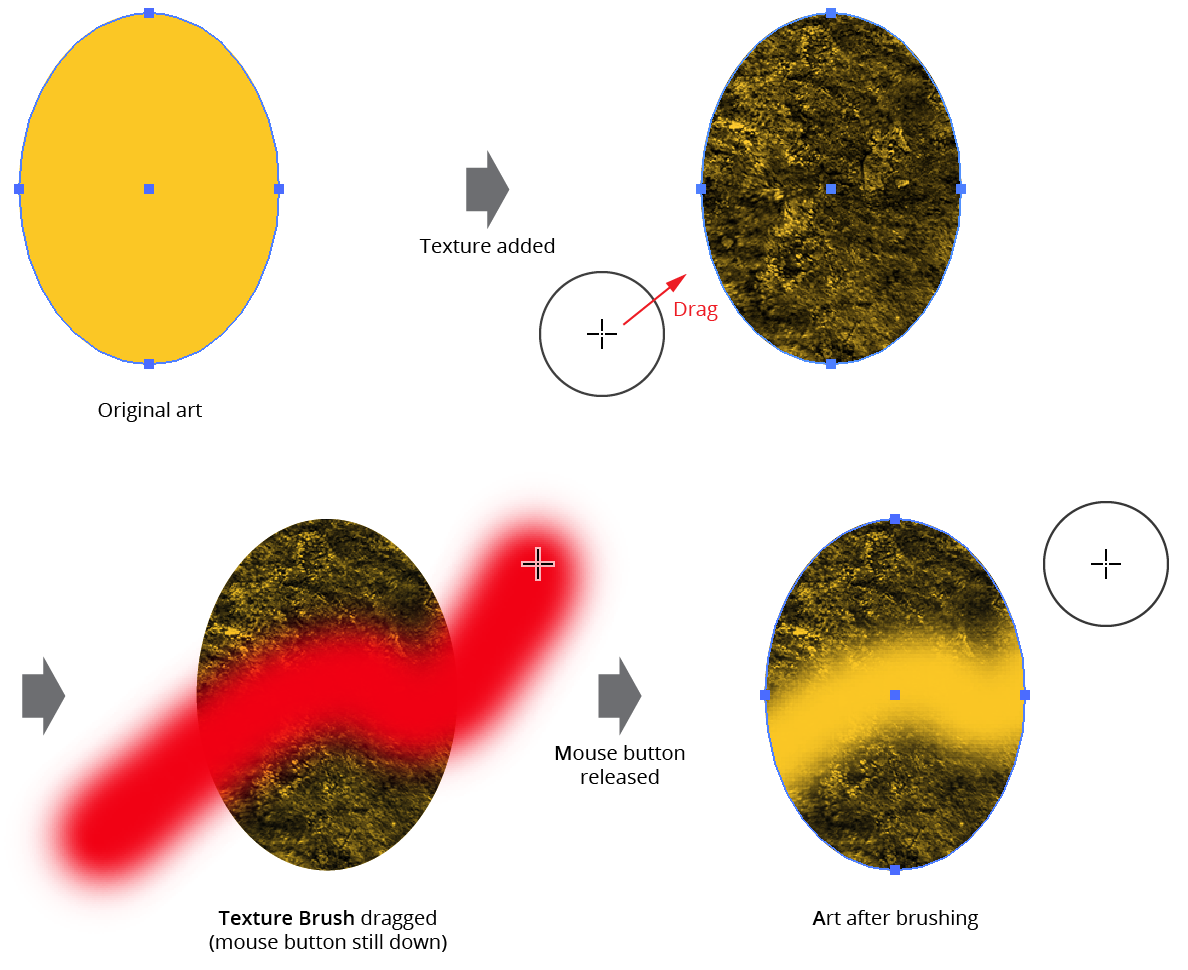
Texture Brush Example
The Texture Brush tool’s preview can be changed in its preferences; by default, it is red and shows its size, hardness, and opacity faithfully, similar to how a Photoshop brush would draw. Due to technical limitations of Illustrator, this requires CPU preview to be enabled in order to display properly when brushing long distances.
If the Option/Alt key is held down before brushing, the tool will be set to “erasing” mode, whereby each brush stroke adds opacity to the texture (up to a maximum of 100%), instead of removing it. Like other brush tools, the diameter of the brush can be changed at any time it is active by pressing the keys assigned in the native Keyboard Shortcuts dialog to “Decrease Diameter” and “Increase Diameter.” For English language installations, these default to the open square bracket and close square bracket keys ([ and ]).
Another way to change the brush diameter (and hardness) is to hold down Shift-Option/Alt and click-drag the mouse; this adjusts the diameter. After releasing Shift-Option/Alt (and with the mouse button still down), a second drag will adjust the hardness.
While brushing (i.e., with the mouse button down), several keypresses can be used:
Shift: Constrains the brush motion to the nearest increment of 45° around the general constrain angle.
Left/Right Arrow: Decreases or increases the brush diameter.
0–9: Sets the brush opacity. 1 sets the opacity to 10%, 2 to 20%, etc.
D: Changes the drawing annotation color, cycling through red, blue, magenta, green, black, and white.
E: Changes the erasing annotation color, cycling through red, blue, magenta, green, black, and white.
To reset, invert, or remove the opacity mask created by the Texture Brush tool, use the Texture Brush panel.
Illustrator Location:
Illustrator Main Menu > Window > Astute Graphics > Texture Brush
The menu item to show and hide the Texture Brush panel can be found in the main menu under Window > Astute Graphics > Texture Brush.
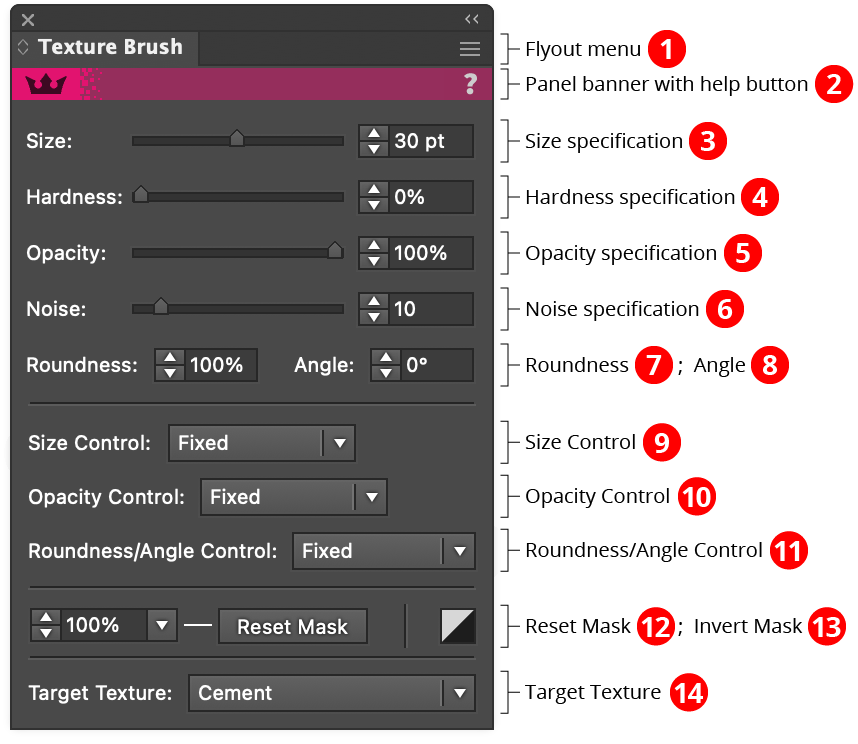
Texture Brush Panel
1. Flyout menu
See Texture Brush Panel: Flyout Menu.
2. Panel banner
The help button on the right opens the help documentation in the Astute Manager. If this does not automatically appear, please ensure your Astute Manager is running first.
Click on the other area of the color bar to activate the Texture Brush tool. This is a quick method of locating the tool within the default Advanced toolbar or a custom toolbar.
3. Size Specification
The size (diameter) of the brush, from 1pt to 1000pt.
4. Hardness Specification
The hardness of the brush, from 0% to 100%.
5. Opacity Specification
The opacity of the brush, from 0% to 100%.
6. Noise Specification
The amount of noise in the brush, from 0 (no noise) to 100 (maximum noise).
7. Roundness
The roundness of the brush, from 10% (highly elliptical) to 100% (circular).
8. Angle
When the brush is not at 100% roundness, the angle of the major axis of its elliptical shape.
9. Size Control
Visible when the panel is expanded. When using a mouse as the input device, it should be set to Fixed; otherwise, enables the brush size to be controlled by either the pressure or wheel setting of a stylus-like device.
10. Opacity Control
Visible when the panel is expanded. When using a mouse as the input device, it should be set to Fixed; otherwise, enables the brush opacity to be controlled by either the pressure or wheel setting of a stylus-like device.
11. Roundness/Angle Control
Visible when the panel is expanded. When using a mouse as the input device, it should be set to Fixed; otherwise, enables the brush opacity to be controlled by either the tilt/bearing or tilt/rotation setting of a stylus-like device.
12. Reset Mask
Visible when the panel is expanded. The value input specifies the base opacity of the entire mask when it is reset (or first created, if the tool preference Base Opacity Applies to New Masks is enabled), with a default of 100%. The Reset Mask button resets the mask, removing all existing brush strokes that may have been made to it and filling it with the base opacity specified in the value input box.
13. Invert Mask
Visible when the panel is expanded; inverts the texture opacity mask.

Texture Brush Panel Invert Mask
14. Target Texture
When multiple textures exist in the selected art object, or multiple objects are selected, the Target Texture menu controls which texture’s masks will be affected (each texture has its own independent opacity mask). By setting the popup menu to All Visible, all tool and panel operations (brushing, resetting, and inverting the mask) will be applied to the mask of every visible texture. Otherwise, these operations will be applied only to the specific texture chosen in the menu (if a single object is selected) or to the topmost visible textures (if multiple objects are selected).
Illustrator Location:
Advanced Toolbar > Width Brush Tool
After the Width Brush tool is selected, its size can be changed either in its preferences dialog (see Width Brush: Preferences) or by pressing the keys assigned to Decrease Diameter and Increase Diameter in the native Keyboard Shortcuts dialog (the left and right square bracket keys respectively, by default, for English language keyboards). Its hardness, ranging from 0% to 100%, can only be changed in the preferences dialog.
When at least one path with a variable width stroke (or stroke that can be converted to a variable width stroke) is selected, clicking on it with the brush or dragging the brush across it will widen or narrow the stroke(s). Annotations will dynamically update while the mouse button is down to show the current stroke width:

Width Brush Basic Example
The brush only makes one adjustment per drag; i.e. it does not flow continuously like a Photoshop airbrush. For example, if the adjustment were set to add the fixed amount of 3 pt of width to a stroke, then moving the cursor back and forth over a path will only add 3 pt at most, regardless of how many times the cursor passes over it. However, releasing the mouse button and making a new drag could add up to another 3 pt, and so on.

Width Brush Second Drag
Brush hardness affects the smoothness of the transition between the original stroke width and the adjusted stroke width, as only positions towards the center of the brush get maximum adjustment:

Width Brush Hardness Comparison
Before pressing the mouse button down to click or drag, there are two keypresses which can be used:
Shift: All adjustments will be in the reverse direction. In other words, if the brush were set to add 1.7 mm to all stroke widths, then instead it would subtract 1.7 mm. If it were set to double stroke widths (e.g. make them 200% of their original width), then stroke widths would be instead halved (e.g. make them 50% of their original width).
Option/Alt: Makes the tool act exactly like the Width Eraser tool, which visualizes the width markers on the path(s) and removes those that the tool is passed over (except those at the start and end of the path). Its diameter is taken from that last used in the actual Width Eraser tool, and cannot be changed.
While dragging with the tool, the X key can be pressed to toggle its annotations on and off. This allows you to see the original width of the stroke(s). Annotations are drawn in the same color as that used for the Width Gradient tool.
